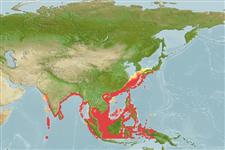Common names from other countries
>
Scombriformes (Mackerels) >
Scombridae (Mackerels, tunas, bonitos) > Scombrinae
Etymology: Scomberomorus: Latin, scomber = mackerel + Greek, moros = silly, stupid (Ref. 45335).
Environment: milieu / climate zone / depth range / distribution range
Ekologi
marina; havsvandrande (Ref. 51243). Tropical; 39°N - 6°S, 70°E - 138°E (Ref. 168)
Indo-West Pacific: west coast of India and Sri Lanka along the continental shelf eastward to Sumatra, Indonesia and Singapore, and northward to China, Korea (Ref. 9684) and Wakasa Bay, Sea of Japan. Does not extend past Sumatra in the East Indies (Ref. 9684).
Length at first maturity / Size / Vikt / Age
Maturity: Lm ?, range 75 - ? cm
Max length : 150 cm FL hane/ej könsbestämd; (Ref. 168); common length : 60.0 cm FL hane/ej könsbestämd; (Ref. 168); publicerad maxvikt: 15.0 kg (Ref. 168)
Taggstrålar i ryggfenan (totalt) : 14 - 17; Mjukstrålar i ryggfenan (totalt) : 20 - 24; Taggstrålar i analfenan: 0; Mjukstrålar i analfenan: 20 - 24; Ryggkotor: 46 - 47. Interpelvic process small and bifid. Lateral line with many auxiliary branches extending dorsally and ventrally in anterior third, gradually curving down toward caudal peduncle. Intestine with 4 folds and 5 limbs. Swim bladder absent. Body covered with small scales. Sides silvery with spots scattered along lateral median line.
Feeds on small schooling fishes, such as sardines and anchovies and on shrimps. This species makes up an important part of the drift net fishery in Palk Bay and the Gulf of Mannar. Marketed fresh and dried-salted (Ref. 9684).
Life cycle and mating behavior
Maturities | Reproduktion | Spawnings | Egg(s) | Fecundities | Larver
Collette, B.B. and C.E. Nauen, 1983. FAO Species Catalogue. Vol. 2. Scombrids of the world. An annotated and illustrated catalogue of tunas, mackerels, bonitos and related species known to date. Rome: FAO. FAO Fish. Synop. 125(2):137 p. (Ref. 168)
IUCN Red List Status (Ref. 130435)
CITES (Ref. 128078)
Not Evaluated
Threat to humans
Harmless
Human uses
Fiskeri: mindre kommeriell; sportfisk: ja
Verktyg
Special reports
Download XML
Internet-källor
Estimates based on models
Preferred temperature (Ref.
115969): 20.1 - 28.6, mean 27.3 (based on 823 cells).
Phylogenetic diversity index (Ref.
82804): PD
50 = 0.5000 [Uniqueness, from 0.5 = low to 2.0 = high].
Bayesian length-weight: a=0.00832 (0.00383 - 0.01808), b=3.03 (2.86 - 3.20), in cm Total Length, based on LWR estimates for this Genus-body shape (Ref.
93245).
Trofisk nivå (Ref.
69278): 4.2 ±0.74 se; based on food items.
Resiliens (Ref.
120179): Mellan, lägsta populationsfördubblingstid 1,4-4,4 år (Preliminary K or Fecundity.).
Fishing Vulnerability (Ref.
59153): Very high vulnerability (90 of 100).
